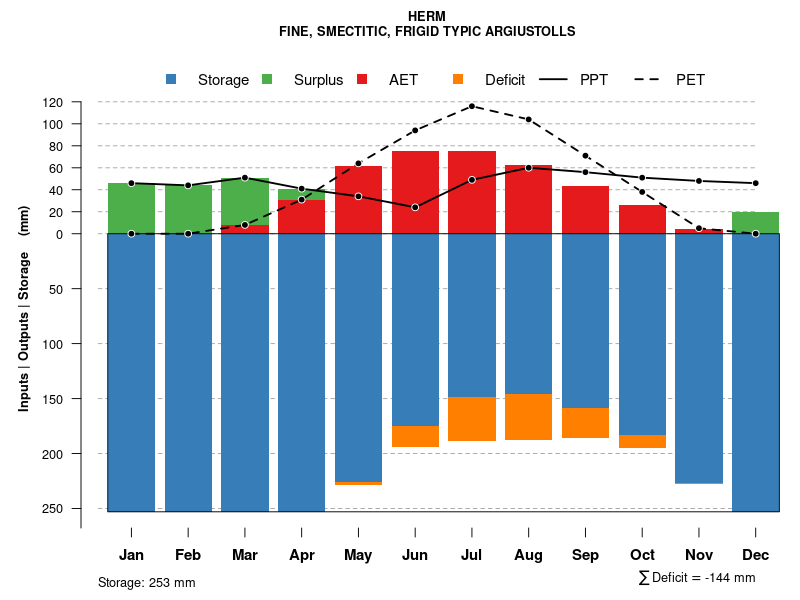| Herm family, 5 to 25 percent slopes, very stony | Hm | 241 | 95470 | 36bp | co626 | 1974 | 1:24000 |
Herm family, 5 to 25 percent slopes | 532M | 3911 | 509868 | k3kc | co636 | 2011 | 1:24000 |
Herm-Fughes complex, 10 to 20 percent slopes, extremely bouldery | 98 | 12 | 3106843 | jpg8 | co648 | | 1:24000 |
Herm-Kolob families complex, 40 to 65 percent slopes | 333C | 7854 | 1414938 | 1jhc5 | co654 | | 1:24000 |
Herm-Fughes families complex, 5 to 40 percent slopes, eroded | 430B | 3442 | 1415024 | 1jhfy | co654 | | 1:24000 |
Cerro-Herm complex, 15 to 40 percent slopes | GM117 | 87 | 3312836 | 30gvc | co654 | | 1:24000 |
Herm-Fughes-Kolob family complex, 25 to 40 percent slopes | 158 | 34861 | 509517 | k361 | co660 | 1994 | 1:24000 |
Cerro-Herm complex, 15 to 40 percent slopes | 117 | 5276 | 509464 | k34b | co660 | 1994 | 1:24000 |
Weed-Herm complex, 0 to 25 percent slopes | 195 | 3845 | 509565 | k37l | co660 | 1994 | 1:24000 |
Cerro-Herm complex, 0 to 15 percent slopes | 116 | 1561 | 509463 | k349 | co660 | 1994 | 1:24000 |
Herm-Kolob families complex, 40 to 65 percent slopes | 333C | 313 | 3176923 | 1jhc5 | co661 | 1968 | 1:31680 |
Herm family, clay loam, cool, 3 to 12 percent slopes | C2-V | 14422 | 1710631 | 1vf1n | co668 | 2018 | 1:24000 |
Herm family, clay loam, 3 to 12 percent slopes | C2-CD | 4976 | 737743 | srp5 | co668 | 2018 | 1:24000 |
Herm family, clay loam, 12 to 25 percent slopes | C2-E | 3493 | 737742 | srp4 | co668 | 2018 | 1:24000 |
Herm family-Dulcepeak, stony complex, 3 to 25 percent slopes | M5-D | 1962 | 499282 | jrjw | co668 | 2018 | 1:24000 |
Herm family-Echolake complex, 3 to 10 percent slopes | C3-CD | 1687 | 737744 | srp6 | co668 | 2018 | 1:24000 |
Herm family-Echolake, cool complex, 3 to 10 percent slopes | C3-V | 1400 | 1711901 | 1vgcm | co668 | 2018 | 1:24000 |
Herm family, clay loam, warm, 12 to 25 percent slopes | C2-EV | 414 | 1868376 | 20q66 | co668 | 2018 | 1:24000 |
Herm loam, 6 to 25 percent slopes | 37 | 8790 | 58297 | 1ynk | co669 | 1982 | 1:24000 |
Herm variant clay loam, 2 to 8 percent slopes | 38 | 802 | 58298 | 1ynl | co669 | 1982 | 1:24000 |
Herm loam, 3 to 25 percent slopes | 40 | 960 | 614331 | nm84 | co670 | 2005 | 1:24000 |
Herm very cobbly loam, 15 to 40 percent slopes | 50 | 2532 | 57660 | 1y00 | co671 | 1997 | 1:24000 |
Fughes-Herm complex, 1 to 35 percent slopes | 40 | 1110 | 57643 | 2wqy8 | co671 | 1997 | 1:24000 |
Herm-Pagoda complex, 0 to 15 percent slopes | 51 | 468 | 57667 | 1y07 | co671 | 1997 | 1:24000 |
Herm loam, 6 to 25 percent slopes | 49 | 12 | 57654 | 1xzt | co671 | 1997 | 1:24000 |
Burnson-Herm complex, 15 to 30 percent slopes | 16 | 6 | 57604 | 1xy6 | co671 | 1997 | 1:24000 |
Herm-Pagoda complex, 0 to 15 percent slopes | 508 | 9668 | 507188 | k0rx | co672 | 2003 | 1:24000 |
Burnson-Herm complex, 15 to 30 percent slopes | 553 | 3216 | 507200 | k0s9 | co672 | 2003 | 1:24000 |
Fughes-Herm complex, 1 to 35 percent slopes | 58 | 3034 | 737693 | 2wqy8 | co672 | 2003 | 1:24000 |
Fughes-Herm complex, 25 to 45 percent slopes | 59 | 588 | 737694 | srml | co672 | 2003 | 1:24000 |
Herm loam, 6 to 25 percent slopes | 937 | 113 | 507299 | k0wh | co672 | 2003 | 1:24000 |
Herm-Fughes-Godding complex, 5 to 45 percent slopes | 122 | 600 | 505174 | jyny | co674 | 1998 | 1:24000 |
Herm-Fughes complex, 10 to 20 percent slopes, extremely bouldery | 98 | 7027 | 497279 | jpg8 | co686 | 1992 | 1:31680 |
Caballo-Herm complex, 3 to 40 percent slopes | CcE | 2370 | 2770140 | 2tl8c | nm672 | | 1:24000 |
Herm-Ishkoten complex, 5 to 50 percent slopes | HkF | 512 | 2770218 | 2v5qh | nm672 | | 1:24000 |
Herm-Dulcepeak, stony complex, 3 to 25 percent slopes | HdE | 2485 | 2934509 | 2wkzr | nm678 | | 1:24000 |
Herm-Lomapedro families complex, 0 to 15 percent slopes | 287 | 2014 | 2934313 | 2wgl5 | nm678 | | 1:24000 |
Herm-Dula, frequently flooded complex, 0 to 15 percent slopes | HmD | 249 | 2934508 | 2wkzq | nm678 | | 1:24000 |
Herm-Dulcepeak complex, 3 to 25 percent slopes | 560 | 11704 | 57524 | 1xvm | nm698 | 2000 | 1:24000 |
Herm-Iles stony loams, 3 to 25 percent slopes | 38 | 17378 | 55358 | 1vlr | ut633 | 1983 | 1:24000 |
Herm-Tomasaki-Falcon complex, 25 to 65 percent slopes | 39 | 17338 | 55359 | 1vls | ut633 | 1983 | 1:24000 |
Toone-Sirref-Herm complex, 10 to 30 percent slopes | 94 | 10106 | 55420 | 1vnr | ut633 | 1983 | 1:24000 |
Herm clay loam, 8 to 20 percent slopes | 37 | 1697 | 55357 | 1vlq | ut633 | 1983 | 1:24000 |
Beavmid-like-McCort-like-Herm complex, 10 to 40 percent slopes | 9319 | | 3253425 | 2ztll | wy629 | | 1:24000 |















